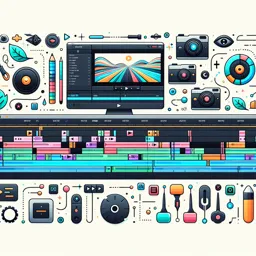Adobe After Effects is a powerful tool for creating visually stunning animations and effects, and its 3D capabilities allow users to elevate their projects to new heights. Whether you’re working on a motion graphics video, a product showcase, or a creative visual, adding 3D elements can bring depth and realism to your work. Here’s a step-by-step guide on how to incorporate 3D elements into your After Effects projects.
1. Enable 3D Layer Mode
The first step to working with 3D elements in After Effects is enabling 3D on your layers. In the Timeline panel, you’ll find a small 3D Layer switch next to each layer, represented by a cube icon. Clicking this activates 3D mode for that layer, allowing you to manipulate it in 3D space (X, Y, and Z axes).
How to Enable 3D:
- Go to the Timeline panel.
- Find the 3D Layer switch and click the cube icon next to the layer you want to turn into 3D.
- Now you can move, rotate, and position the layer in 3D space.
2. Use 3D Camera Tools
After enabling 3D, you can add depth to your project by using After Effects’ built-in camera tools. The camera simulates real-world camera movements, allowing you to pan, zoom, and tilt around your 3D elements. This adds dynamism to your scene and helps create more immersive animations.
How to Add a 3D Camera:
- Right-click in the Composition panel and select New > Camera.
- Choose your camera settings, such as focal length and angle of view.
- Use the camera tools to move around the 3D space.
3. Position and Rotate Layers in 3D Space
Once a layer is in 3D mode, you can move and rotate it on the X, Y, and Z axes. This allows you to place elements at different depths, angles, and perspectives to create a more dynamic composition.
How to Adjust 3D Positioning:
- Select the 3D layer you want to manipulate.
- Press P for position or R for rotation in the Timeline.
- Adjust the X, Y, and Z values to move or rotate the layer in 3D space.
4. Add 3D Lights for Realistic Effects
Lighting plays a crucial role in making 3D elements look realistic. After Effects offers several types of lights—such as spotlights, point lights, and ambient lights—that you can use to illuminate your scene and add shadows.
How to Add Lights:
- Right-click in the Composition panel and select New > Light.
- Choose the type of light (e.g., point, ambient, spotlight) and adjust the intensity and color.
- Position the light in 3D space to cast shadows or highlight specific elements.
5. Apply 3D Text and Shapes
Text and shapes can also be transformed into 3D layers in After Effects. Once in 3D, you can extrude the text or shape, giving it a solid, dimensional look. You can combine this with camera movement and lighting for polished, professional results.
How to Create 3D Text:
- Create a text layer and enable 3D mode.
- In the Geometry Options of the text layer, increase the extrusion depth to give the text a 3D appearance.
- Add lights and adjust the position of the text for added realism.
6. Render with 3D Effects
After completing your 3D animation, ensure that your render settings are optimized for 3D effects. Using the Cinema 4D Renderer or the Classic 3D Renderer, you can render your project with high-quality 3D results.
How to Render:
- Go to the Composition Settings and select 3D Renderer from the options.
- Choose Cinema 4D or Classic 3D based on your project’s complexity.
- Adjust the render settings for best performance and quality.
Conclusion
Adding 3D elements to your After Effects projects can greatly enhance the visual appeal of your work. By mastering 3D layers, camera tools, lighting, and rendering techniques, you can create compelling animations and graphics with depth and realism. Whether you’re a beginner or an experienced motion designer, After Effects’ 3D tools provide endless possibilities for creative expression.
































